PREDICTION COMES TRUE!In 1996 BFS predicted that when it comes to home runs . . . "You ain't seen nothin' yet!"By Greg Shepard Published: Winter 1998 We have all witnessed baseball's most extraordinary year with the home run hitting of Mark McGwire and Sammy Sosa. Two year's ago in our 1996 BFS Winter Edition I wrote an in-depth article on baseball as to why a record number of home runs were hit and made a big deal with the phrase, “You ain't seen nothin' yet.” We featured McGwire, Sosa and Alex Rodriguez. As predicted these great athletes all had record breaking years this past season. The following are excerpts from this 1996 article: Was this year a fluke (1996)? Just one of those things? Or was there a reason why so many home runs were hit this year? The media has come up with everything under the sun except the real reason. Most baseball coaches are scratching their heads. One group of people has it all figured out and that is the players themselves. You think this year (1996) was awesome for home runs? Well, you ain't seen nothin' yet! For the next twenty years, you will continue to see a meteoric rise in the number of home runs hit out of the park. The players know it isn't the ball, bat, fields or anything else except the strength and conditioning factor. Most of the players are lifting and think that it is important. Mark McGwire lists working out as one of his favorite things to do. All the teams now have a strength coach. This is all new to baseball. But, even today there are actually still some coaches who will tell you that baseball players should not lift weights. Amazing! As the players and coaches learn how to lift like football players or track athletes, they will continue to improve. What will happen next year (1997) or the year after (1998)? The answer to that is easy and should be abundantly obvious. “You ain't seen nothin' yet.” We all know that McGwire hit 70 home runs this year and Sosa had 66 round trippers. However, for the first time in history, four players hit 50 or more home runs: McGwire, Sosa, Griffe and Vaughn. Also, three players hit over 150 RBI's: Gonzales, Belle and Sosa. Only one player (Tommy Davis 1962 with 153) had been able to hit more than 150 RBI's since 1950 prior to 1998. Alex Rodriguez set a major league record for most home runs (42) by a shortstop. Alex also had 124 RBI's and a league leading 213 hits and he is just a young kid. More and more players will enter the major leagues with a strength training background. More and more players will be doing more and more things correctly as far as strength and conditioning. People say that this year was a once in a lifetime thing. Well, the McGwire-Sosa race right down to the wire will be tough to match but players will continue to keep hitting more as they get stronger, more flexible and more powerful. I say again, “You ain't seen nothin' yet!” What about pitchers? Won't they throw the ball faster with increased leg and hip power? The answer to that is “Yes.” Well then, won't it just kind of even out? Won't the batters strike out more often because of the speed of the pitch? Maybe, but more home runs will continue to be hit because of the speed of the pitch. Scientists have determined that the faster the pitch, the more transfer of energy to the hit. So, you still ain't seen nothin' yet! WHAT SHOULD BASEBALL PLAYERS DO? Baseball is the last frontier in the epic saga of strength and conditioning history. The first athletes to figure out the strength and conditioning secret were the throwers in track and field. As soon as this secret became widely known in the late 1960's, the marks for the Discus, Shot Put, Hammer and Javelin skyrocketed. Many of these throwers were around 6-4 and 270 pounds with 4.6 speed. Some even better than that. Other sports started to learn this secret: football programs started learning in the 1970's, basketball in the 1980's and baseball in the 1990's. However, there are still some huge misconceptions prevalent in all sports but especially baseball since they are the last ones to weight train. Most important is the understanding of the source of power in throwing or hitting. At first glance, it would seem to be centered in the arms. After all, you hold the ball and bat with your hands. Therefore, many baseball players who do lift concentrate on wrist curls, forearm and shoulder work. This should never be the main thrust. The exercises for these areas are called specific auxiliary exercises. The true source of strength and power for a baseball player is centered in the hips and legs. Look at the photos of the two athletes shown from the waist down. One is Sammy Sosa who hit 66 home runs this year. The other is of a Discus thrower. Notice the similarity of the hip and leg position as you look at their full picture on the next page. If a Discus thrower were to train only on upper body specific auxiliary and even lifts, he would fail miserably because of lack of leg and hip strength and explosive power. Maximizing a baseball player's potential does not mean doing leg extensions, leg curls and machine hip and leg exercises for the lower body. Baseball players must Parallel Squat and Power Clean to develop their maximum power. If baseball players were to really get after these two lifts and do them correctly, you'd have to do one of two things. Either move the fences back another 50 feet or get used to football-like scores. Baseball players should also do quick foot drills, stretch for speed and jumping power, sprint train and plyometric train. We also do not want to overtrain in the weight room. The maximum time in the weight room should be 45 to 75 minutes three times per week in the off-season and two 30-45 minute workouts twice per week during the season. GET STARTED NOW! The best time to start is now. Junior High is a perfect time to start. Get on the BFS Readiness Program. We have the Total Program Book, Readiness Workout Cards, a Readiness Video and even special Readiness equipment. Just give us a call. The high school and college athlete is at the age to really get after it and make success happen. Get the Total Program Book, the Set-Rep Log Book and the Total Program Video. The pro-level is the toughest time to start because there are so many games. Athletes over 28 who play over 100 games a year have a difficult time maintaining a workout schedule and being able to recover. The time to start is now. The younger the better. FINAL NOTE What was the best thing about Mark McGwire's history making 70-home run season? To me, it was his relationship with his son. The towering 500-foot blasts were great but I was more impressed when he hugged his son so often after circling the bases. In our next issue (Spring 1999), we will feature LSU's remarkable baseball program. They are the two-time defending NCAA National Champions. This will be an in-depth feature article with great interviews from players and coaches. They do what they are supposed to do and the results speak for themselves. Look forward to it! ________________________________________ Coach Shepard’s 1996 Prediction: “In the baseball future even smaller players who play shortstop will be hitting home runs.” Alex broke the shortstop home run record in 1998 with 42 round trippers. _______________________________________ Baseball players must Parallel Squat and Power Clean to develop their maximum power. If baseball players were to really get after these two lifts and do them correctly, you’d have to do one of two things. Either move the fences back another 50 feet or get used to football-like scores. |
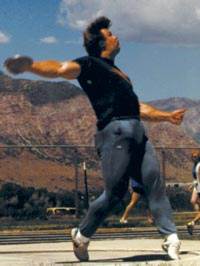 |
|
The legs and hips are the source of strength power for hitting a baseball. Compare this of Stephan throwing the discus with the following picture of Sosa hitting a homerun. |
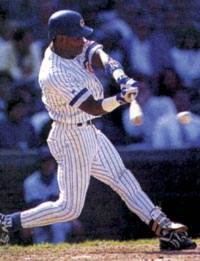 |
|
Sosa's explosive hips and legs are the reason why he can hit so many home runs. Compare his hip and leg place with Stephan's hips and legs in the previous picture. |
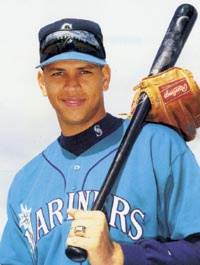 |
|
Alex Rodriguez |
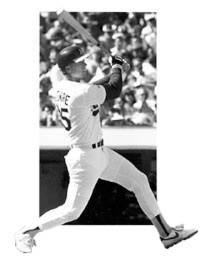 |
|
1987 Mark McGwire |
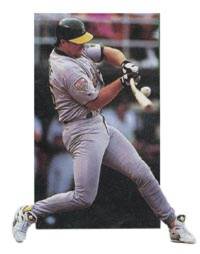 |
|
1996 Mark McGwire |